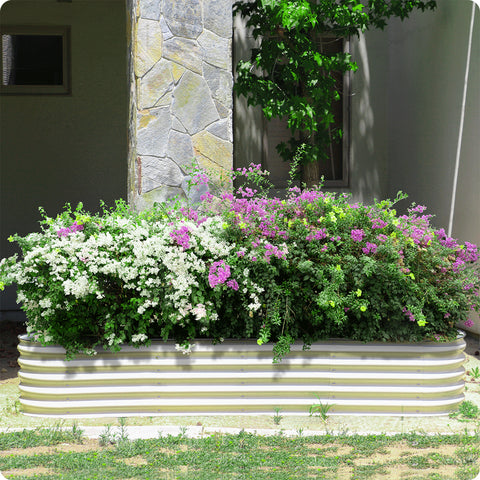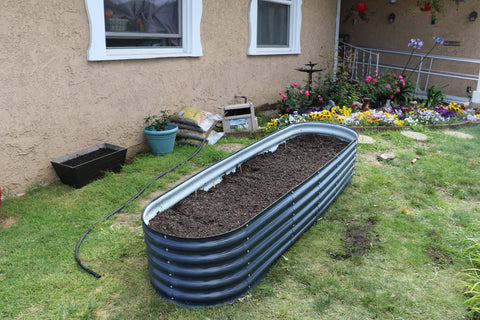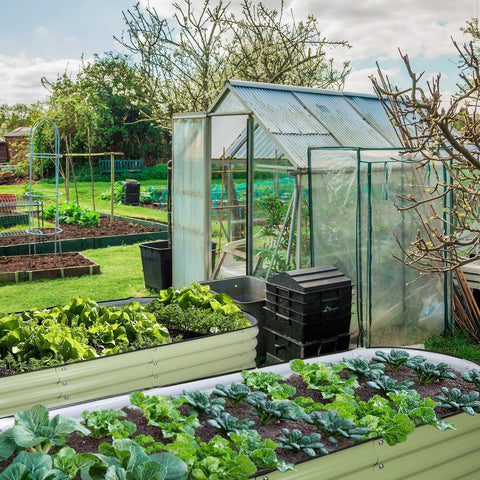Four Tips For Starting A Lasagna Garden On A Raised Garden Bed
The thousand-layer garden, also known as mulching or composting, is a cool no-dug and no-tillage method that can start the raised garden bed. Thousand-panel garden can help you create similar healthy topsoil conditions and benefit your plants. But why create similar conditions instead of directly using topsoil? Simple and healthy soil makes healthy plants! However, due to poor farming practices, about one third of the earth's soil is at risk of moderate to severe degradation.

Nevertheless, with the Millennium Garden, you can bypass the topsoil by creating an organic and nutritious environment for your plants, let your plants thrive and help rebuild the underlying soil. Here are four tips to help ensure the smooth progress of the lasagna garden on your elevated bed!
Benefits of lasagna gardening
The Millennium Garden is a cool way to start the elevated bed! This no-tillage and no-digging gardening technology can help you create similar nutrient topsoil conditions for healthy plant growth. In addition to higher yield, the benefits of the lasagna garden are:
- Time efficiency
It takes hundreds and thousands of years for nature to produce 1/2 inch of soil from the parent rock. Although soil is renewable because it is irreversible in human life, many experts classify it as non-renewable. Thousand-panel garden can help you simulate the ideal growth conditions of topsoil in a reasonable time range, so if you start early, you can start planting for the next growth season.
- Help rebuild the soil
Poor farming methods, such as the use of chemical fertilizers, over-cultivation and non-rotation of crops, lead to soil degradation. Therefore, about one third of the earth's soil has almost no nutrients or organic matter to maintain the healthy growth of plants, and rarely can supplement itself with the pace of modernity. The Qianmian Garden will help you rebuild the soil under the organic material layer without fertilizer.
- Cost effectiveness
Is one person's garbage another's treasure? Yes, when it comes to lasagna gardening! You can easily purchase the organic materials that will be used in the Qianmian Garden from the yard and nearby. It is cheaper to clean up the materials needed to build the Millennium Garden than to obtain the garden soil and pump it with soil conditioner and conditioner to improve its drainage and retention quality.

- Low labor intensity and high output
Thanks to newspapers or cardboard (at the bottom of the lasagna garden) and mulch, you have taken action to reduce weeds. The cardboard will restrain the weeds, and the covering will not let them see the dawn. You don't have to worry about adding fertilizer on the elevated bed, because your lasagna garden is rich in nutritious compost. All of these, the yield is higher, making the lasagna garden worth a try.
Tips for starting lasagna gardening on an elevated bed
Make sure that the material you start layering is organic and does not contain any ingredients that will not decompose, such as production stickers, foam, rubber or glass. Before digging, be sure to wear protective equipment, gloves and goggles.
- Select the area of Qianmian Garden
Your lasagna garden should receive at least six hours of direct sunlight, mottled sunlight and partial and dark shadows every day to ensure the healthy growth of plants. Make sure this position is away from the busy traffic, especially if your elevated bed has no support frame. Because your lasagna garden will have a compost layer, please make sure it is not too close to the open window, because compost can be very smelly!

- Selected organic materials
Your lasagna garden will have alternate layers of green and brown. The green layer is grass dust, fallen leaves, tree or plant pruning, compost and organic kitchen residue, while the brown layer is wood dust, hay, dry leaves and straw. The brown layer accounts for about 45% of the thousand-layer structure, because they are rich in carbon, which is an essential plant macronutrient. The green layer accounts for 55% of the thousand-layer structure, because they are rich in nitrogen, which is another important plant macronutrient.
Professional tips: Do not use meat products as part of vegetables, because it may attract rodents to your garden.
- Use high-quality water for irrigation
Each time the brown material is layered, it needs to be thoroughly watered to fix them in place. During this period, do not use inferior water to wet the lasagna garden. Water with high salinity and high levels of fluoride, chlorine and some ions (such as sodium or boron) is considered to be inferior and will affect your crops and yield.
Poor quality water will accelerate soil degradation, so this is definitely not the garden you want, especially because brown materials create a suitable environment to attract earthworms. You can learn to collect rainwater, which can be used to water the lasagna garden. You can also use this water for indoor plants.

- Pay attention to your raised garden bed material
If you plan to upgrade the raised garden bed to start the lasagna garden, please do not use materials that will immerse toxins into growing crops. Some raised garden bed materials, such as treated wood, methyl bromide trays and railway sleepers, are unsafe to use in the garden. Instead, choose untreated wood, galvanized steel and natural stone as your raised garden bed. If you take care of and maintain garden beds, their service life will be longer.
Build your lasagna garden
Now that you are ready to build a thousand-layer garden, you need to ensure that all green and brown layers are organic and free of chemicals. Before layering, please remove any food stickers, plastic wrap or other inorganic materials that will not decompose.
- Laying the foundation
The first step is to add a 4-inch deep twig and branch layer at the bottom to help drain water. Make sure that any branches or branches you add are free from disease or chemical substances.
- Add your brown
Now add a mixture of crushed newspaper, cardboard, dried leaves and straw or sawdust. This layer should be between 2 and 8 inches deep. Thoroughly water the brown layer before proceeding.
- Add your green vegetables
Your green layer should contain compost, kitchen residue (excluding meat), dung, plant pruning, grass dust, used coffee grounds and tea. This layer should be about 2 to 6 inches deep. Make sure that the plants you add are free of pests and diseases, and that the kitchen residue is organic. First layer 2 inches of compost and dung, then 2 to 4 inches of plant pruning, grass, coffee grounds and tea.

- Repeat!
Now all you need to do is repeat these layers, alternating between green and brown layers. Remember to water thoroughly every time you add a brown layer to keep the material in place and accelerate the decomposition. Continue alternating until you almost reach the top of the garden bed. When you are at the top, end with a brown layer to prevent rodents and pests from leaving the garden. Water thoroughly to promote the diffusion of nutrients to multiple layers and keep them in place.
- Waiting for planting
If you start this process in autumn, you can start planting in spring. If not, you need to wait four to five months to be ready for use. This will give your garden enough time to decompose and transform into nutritious soil to promote the healthy growth of plants. Before planting, add 6 inches of topsoil on the raised garden bed. Heavy-duty feeders like tomatoes and peppers will be happy to grow in your lasagna garden!
At the time of your last harvest, most organic matter will decompose and your lasagna garden will shrink. The rest is to restart the process; Of course, you should have more green and brown by then!
No lasagna!
Unlike hot compost, lasagna gardening is a cool way to start raising the garden bed. This is a highly nutritious and chemical-free way to plant plants and improve the soil at the same time. As long as you keep the location and garden bed materials, you can easily remove the organic materials required for the layered lasagna garden.
